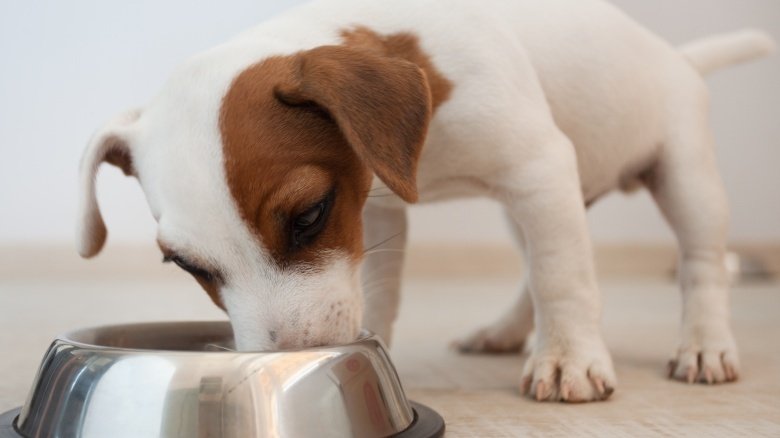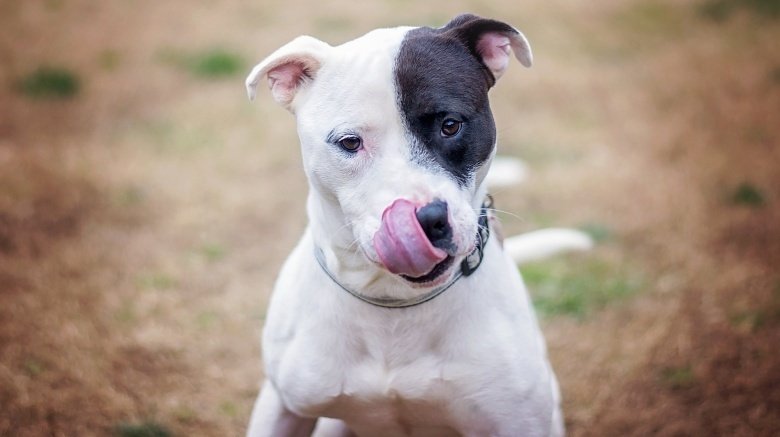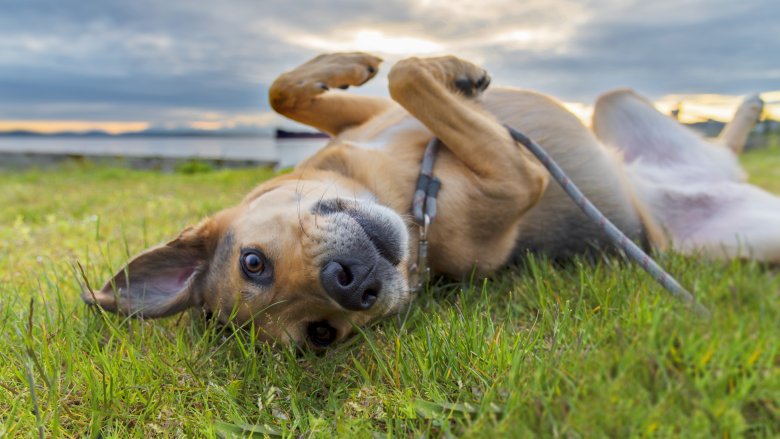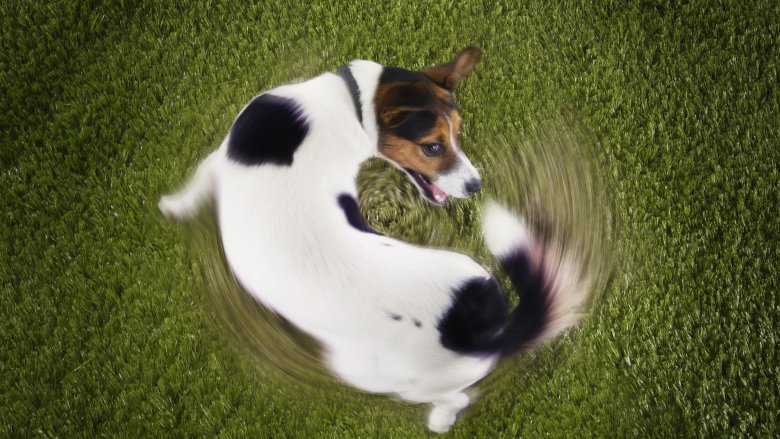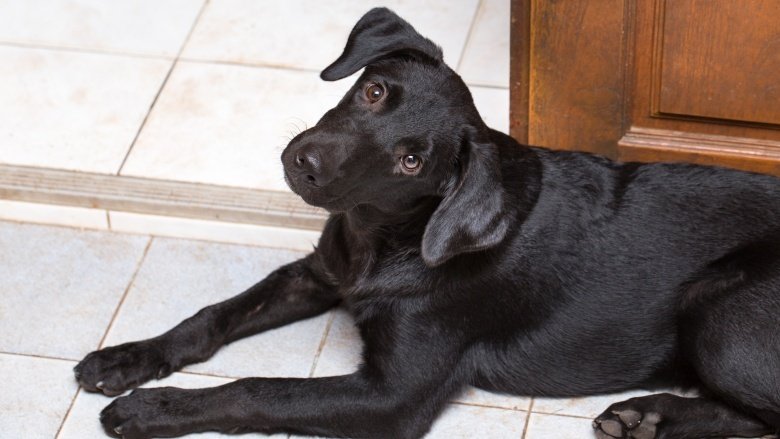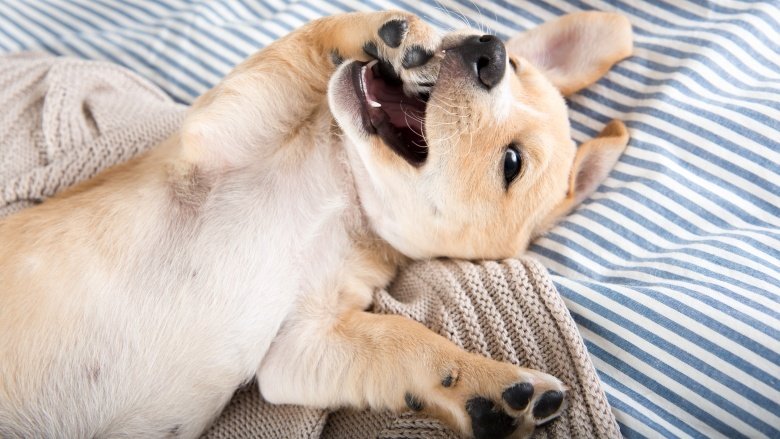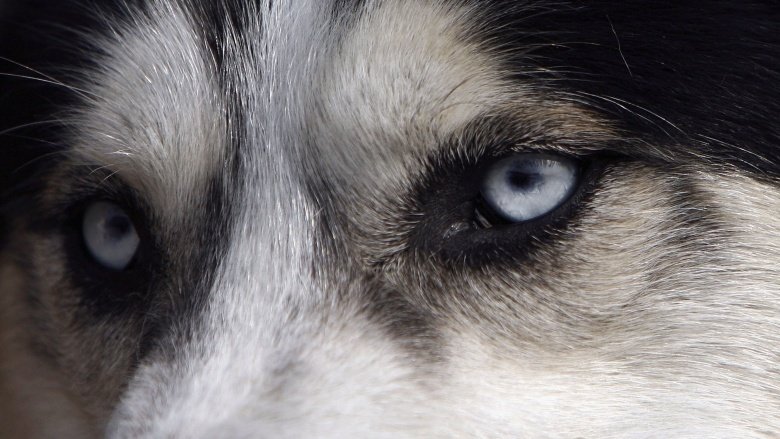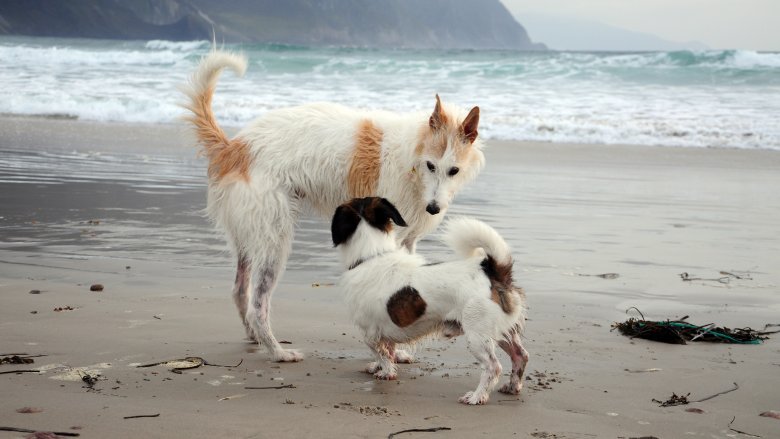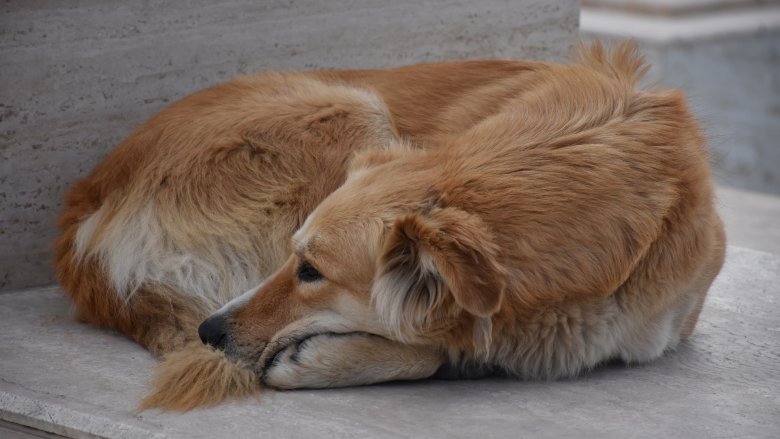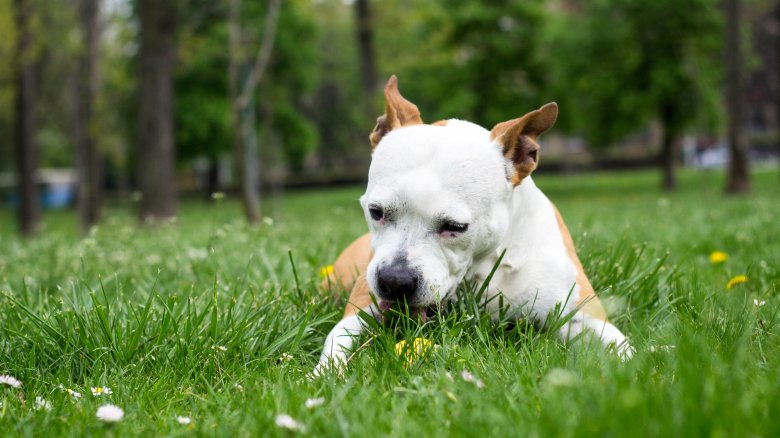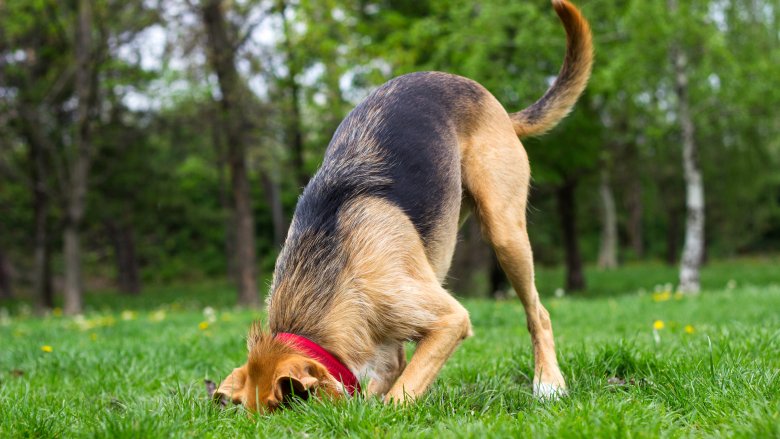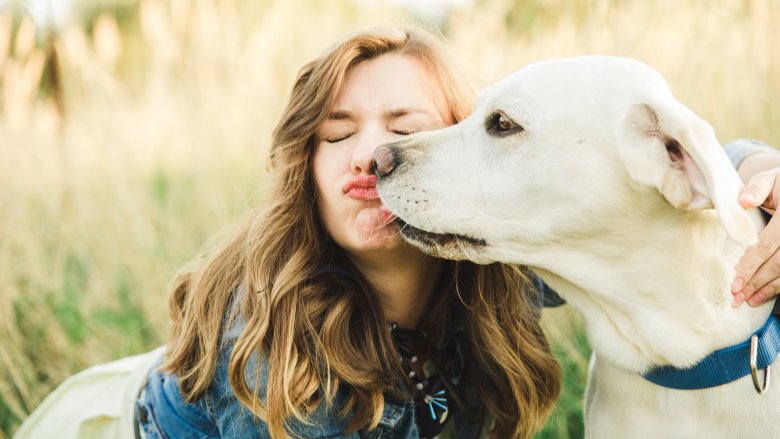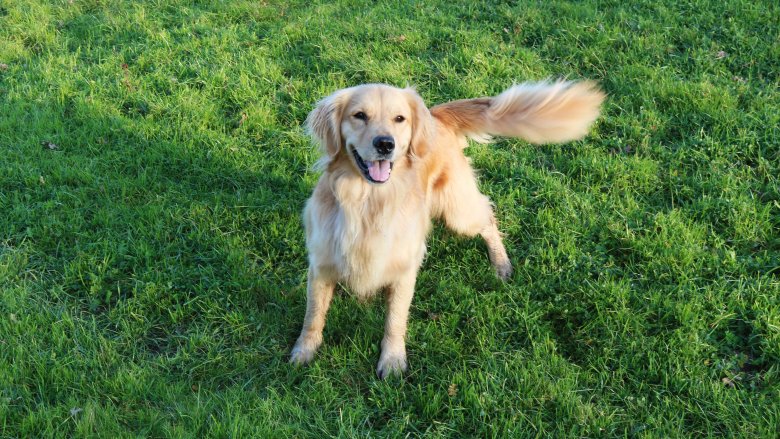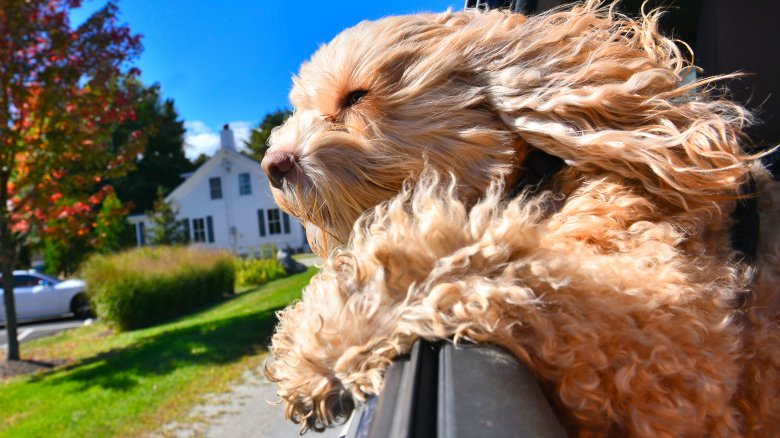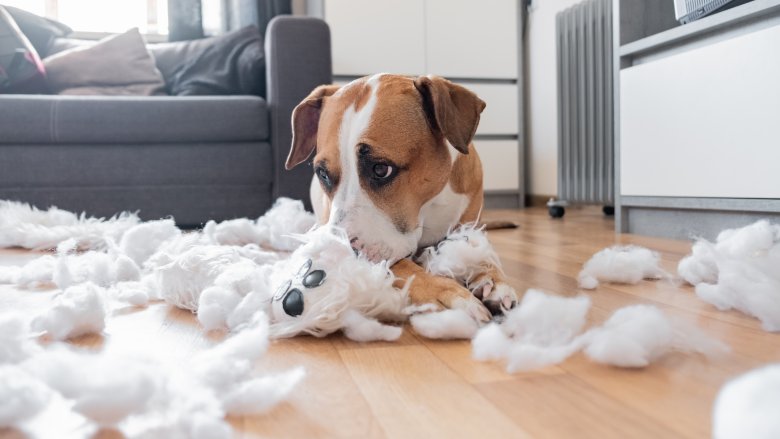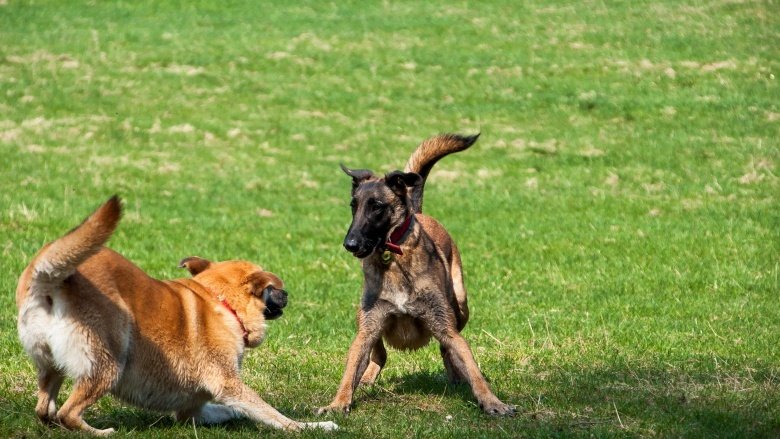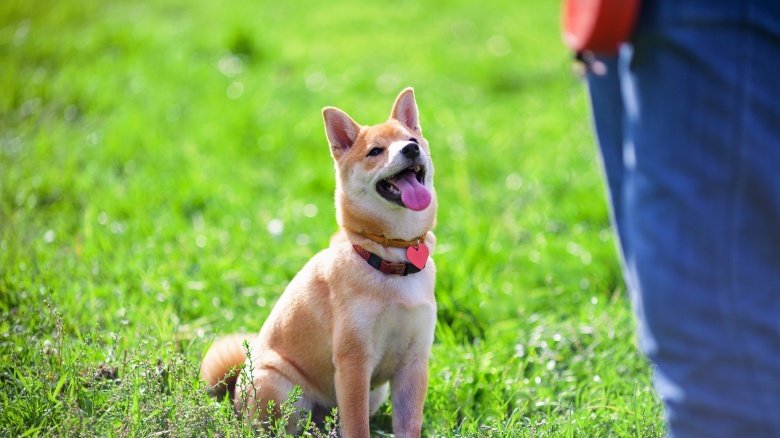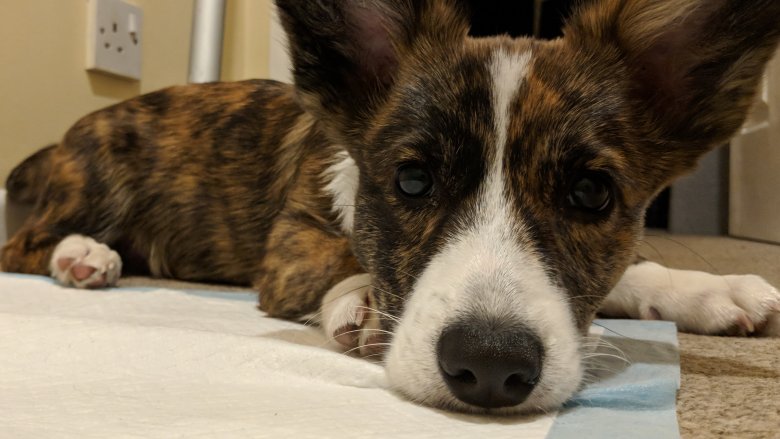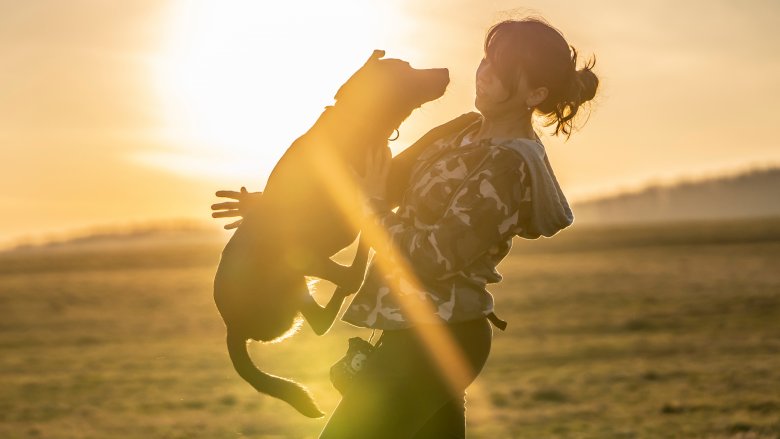The Real Reason Dogs Tilt Their Heads And Other Canine Facts
The whole "dog" thing is pretty crazy if you think about it. Somehow, humans managed to trick an entire line of dogs into believing that humans were just the best things ever. And they're still buying it, thousands of years later. The bonds many of us have with our canine companions are unlike any other friendships or relationships we have. Some of us love our dogs like children, and it's no wonder. There's an unconditional friendship there that makes everything better, and doesn't it seem like they love us back, too? Knowing what's happening inside those precious, perfect little heads can only make us understand them better.
Ready? Then holler out Poppy's name in that authoritative voice and then in that goofy voice you do for some reason, pat yourself or any nearby piece of furniture, give her a good ol' head-scratch or belly-rub, and keep a chew toy to hand while you learn about what's going on in the space between her flop-ears.
Why do dogs always act hungry?
Even if you just fed them five minutes ago, your dog will probably give you those eyes when you're trying to eat your lunch. If their behavior is to be believed, they're one stagger away from collapsing from sheer starvation.
So what's the deal, Pup? It's normal, and it's thought that this behavior is a holdover from when we first started inviting wild dogs to share our campfires and our table scraps. No one knew when the next meal was coming. It was better to chow down on food when it was there, and it's likely that the focus on food is biologically hardwired into our dogs today.
For some dogs, there's always the possibility that they've experienced a life of real starvation. Even after being rescued and re-homed, they can remember what an empty belly is like. Vets will often differentiate between begging dogs that act hungry and dogs whose behavior suddenly changes to become more demanding of food, so it's also important to keep an eye on your puppy in case he goes from begging to ravenous.
Why do some dogs eat poop?
Cat poop, horse poop, unidentified poop, sometimes their own poop. Oof. Poop-eating has a name: coprophagia. There are plenty of reasons a dog might be doing it, and sometimes it's a problem. Other times it's just a disgusting habit. Most puppies grow out of it, but they sample poop at some point because, well, puppies are dumb. Nursing mothers will often eat the poop of their puppies to clean up after them, and some puppies will see Mom doing it and think it's a lesson. Puppy see, puppy do.
Some poops (like cat poops) are just interesting snacks. In some cases, it might be a sign of a behavioral issue brewing. Do they spend too much time alone? Are they doing it just to get your attention? It's entirely possible.
If adult dogs suddenly start wolfing down poopsicles, there might be a problem. They may be trying to add nutrients to their diet if they're on low-quality food or if they're developing some underlying condition like diabetes. Dogs are smart, but dogs can also be kinda gross.
Why do dogs roll in the worst-smelling stuff on the planet?
Any dog owner will recognize the shoulder lean, the butt in the air — Pupper's just found something fun to roll in. It's making your eyes water already, so how can dogs, with their superior sense of smell, even stand it?
Dog behaviorist Stanley Coren notes the things dogs choose to roll in are usually organic things, whether it's the remains of a dead animal or poop. One of Coren's ideas is it's an evolutionary throwback to the days when they were living in packs and hunting. Rolling in something stinky could mask their scent and might allow hunting packs of dogs to get closer to prey before being detected.
His other idea? For dogs, smell is their most powerful sensory input. The stronger a pleasing smell, the happier they are. So basically, your worst fears are true: Pupper really might be rolling in dead things just because he likes being stinky.
Why do dogs chase their tails?
Perhaps nothing amuses humans more than when a dog chases her tail. It's a hilarious behavior, and it's even funnier if she manages to catch it. But what's going on here?
A few things might be happening, and all dogs are different. Some dogs might simply be doing it because they're bored at that moment, and it seems like a fun way to fill the time. For some regular tail-chasers, it might be a sign of a condition called canine CD — OCD for dogs. These dogs might show other kinds of compulsive behaviors, too, from licking to random barking. For some dogs it can be a problem, but it's harmless for others.
Also, oddly, dogs with high cholesterol tend to chase their tails more often. Basically, they have mood changes that go along with their cholesterol levels, which maybe has something to do with the overwhelming urge to catch that durned tail. Dogs could also be doing it to get your attention, but in most cases, it's a harmless behavior.
Why do dogs tilt their heads?
Besides how it's absolutely adorable (like everything else about dogs), we don't know exactly why dogs tilt their heads. Here are the best scientific guesses. Part of our connection with dogs is because their emotional intelligence is off the charts. Perhaps they tilt their heads because they're reading our emotions and looking for the positive response they usually get when they do it. (That's right, maybe your dog is trying to make you smile.)
There are other theories. Depending on the shape of your dog's head, they may be able to better pinpoint a noise if they adjust the position of their ears and clear their line of sight. Dogs with longer muzzles do this more, so it's likely there's some kind of physical or sensory benefit.
Another theory suggests they're just concentrating extra hard, looking and listening for social cues. Experiments on dogs' interpretation of language found they'd tilt their heads different directions when words were spoken with and without emotion, possibly suggesting they have separate processing centers for emotion and words. They're such good, smart dogs. So good.
Do dogs have a preferred paw?
Yep, just like humans, dogs can be either right-handed or left-handed. Unlike humans, there's an equal chance of your dog being either right- or left-paw dominant, or ambidextrous. There are a few different ways you can test to see which your pup is, and it just involves paying attention to which paw is used to do things like give high-fives and steady toys.
Humans have always had a sort of bias against the left-handed — weirdly, researchers have found that the bias might be alive and well in dogs too. They found that left-pawed dogs tend to be more wary, or even aggressive, toward strangers, and even though it's a relatively slight correlation, most guide and service dogs are right-pawed or ambidextrous, as many left-pawed dogs are weeded out because of temperament.
There also seems to be a connection between how dominant your pup's paw preference is and how brave they are. Pups that are ambidextrous tended to be more anxious, while dogs with a strong preference to a dominant paw were quicker to adjust to new situations and were less easily rattled.
What does the world look like through a dog's eyes?
The idea that dogs can only see the world in black, white, and gray is a long-standing myth. University of California studies found dogs really see in shades of blues, grays, yellows, and browns. They can't see some of the most popular dog toy colors on the market today. Things like bright orange and bright red? Those are just nice for us humans.
There are a few other fascinating facts about canine vision that might change the way you see your dog's world. Compared to us, dogs are also nearsighted. They tend to be around 20/75, which means things are fuzzy in the distance (which might explain your dog's reaction to things down the street). They have a huge advantage over us in the dark, though, as their eyes contain a lens called the tapetum lucidim. It reflects what light is available (and makes their eyes glow in photos), and while they're not as good in the dark as cats, they're much better than humans. They have a much wider field of vision than we do, too. While we can see about 190 degrees around us, Fido can see about 250 degrees.
What's with the butt-sniffing?
As a mere human, you're probably baffled by what could possibly be so interesting about dog butts. Plus, some dogs have a sense of smell that's 100,000 times stronger than ours, and seriously, what's with the butt-sniffing? Butt-sniffing dogs are getting a whiff of each others' anal sacs. Chemicals from the sacs contain lots of information (right down to diet and current emotional state), as poorly designed as the whole thing might seem.
Wouldn't other backside smells override any sort of chemical a dog's giving off? Well, the chemical compounds are only half the communication network; dogs have a super-sensitive receptor in their noses called the Jacobson's organ. This receptor is tuned to the particular acids secreted by the anal glands and tunes out fecal smells. That's the same organ used when dogs sniff around the popular pee tree at the dog park.
Your dog just has an odd way of shaking hands. And before you get all judgmental about Pupper's funk, don't forget that humans have the same sort of glands that dogs do. Ours are mostly in our armpits and groin, which is why some dogs are dedicated crotch-sniffers.
What's with the circling around?
Stanley Coren, PhD, decided to get to the bottom of this one. He tested 62 dogs on various surfaces to see what kind of behavior they demonstrated before lying down. He found that dogs who were put into an area with an uneven surface (shag carpeting) were three times as likely to spin in at least one circle before they settled down.
Coren believes that confirms at least part of one theory: they're simply trying to get comfortable. Other parts of the theory suggest that this behavior is also hardwired into them from their wild days and that the circling is partially scaring away any bugs that might bite, kicking away any sharp rocks or sticks, and simply just making the ground more suitable for snoozing.
Why do dogs look so sad?
Dogs are emotionally manipulative creatures. How do dogs manage to nail that heartbreaking, sad expression and con you out of the last nibbles of your dinner? According to the experts at VetStreet, one reason is simply we've gravitated toward those sad eyes for generations of puppers, and we've bred dogs with features that accent the sad look we find so charming. And also, dogs aren't dumb. They probably know if they lie down with their heads on their paws and look up at you, you're going to pay attention. They're not sad — they're manipulating and you love it.
Your pupper might actually be sad, though. According to one pet expert, your dog could be struggling with the changing roles of dogs. Herding and hunting dogs now have different lifestyles, and we suddenly don't need all the traits we've bred into them for generations. Canine sadness can manifest as a lack of appetite, sleeping all day, and a disinterest in playing or walks. Be a good friend. Give your dog meaning.
Kibble and a side salad, please
Grass is for horses and sheep. When dogs eat grass, it makes about as much sense as serving up their kibble with a side salad. Dogs aren't supposed to be into vegetables.
And yet, PetMD says grass-eating is common in dogs. Unlike cats, dogs are not exclusively carnivores, which explains why so many dogs are just as happy to eat your French fries as your burger. Dogs are scavengers, so they'll eat pretty much anything that will give them calories and nutrition, and sometimes that means eating plants. Grass, as it turns out, is easily accessible to modern canines because most of us grow it in our backyards.
Okay, great, but if it's so nutritious, why do dogs sometimes barf it up after they eat it? Well, when a dog gulps down large amounts of unchewed grass, it can tickle the stomach and esophagus, which may induce vomiting. So some dogs might actually be seeking out grass as an emetic, or a substance that makes them barf — possibly because their stomachs don't feel great after eating all those French fries.
So is it a good idea to let your dog eat grass? Yes and no. The grass itself won't hurt your dog, and it might even provide essential nutrients. But if it's grass that's been treated with pesticides or other chemicals, you probably don't want your dog eating it. And if they're eating a lot, watch for vomit. So maybe just offer some cooked vegetables instead, you know, as a side dish.
Just setting this rotting bone aside for hard times
Is your garage stocked with canned food, bottled water, and bags of rice in preparation for the coming apocalypse? Well, you've gone overboard. But you probably have something in common with your dog, who may also do a little apocalypse prepping on the side.
Dogs that bury treats or hide them in their bedding are actually following an ancient instinct, one that has been around since before dogs were dogs. In the wild, wolves may go a week or two between meals, so they will sometimes bury the excess food they get during more prosperous times. That way, they will have something to eat in leaner times. Some dogs instinctively feel the need to store food for those times of famine, even though they've never known a day of famine in their lives. So try not to feel snubbed if your dog doesn't eat those treats right away — burying them is a matter of practicality.
According to I Heart Dogs, soil is a natural insulator, so when the dog's ancestors buried their excess meat in the ground it would be sort of semi-fresh when they went back for it. Semi-fresh and caked with dirt, but whatever. Sometimes survival goes to the guy most willing to eat a little dirt.
Can you please barf up some food for me thanks
If you can get past the whole dog-slobber thing, you might actually like when your dog licks your face ... if you are gross and have no fear of bacteria. But yes, some people are like that. Anyway, you probably think your dog is licking your face out of love. After all, those big slobbery licks seem an awful lot like your dog's version of smooches.
Well, we do hate to burst that big, slobbery bubble, but that licking behavior is also part of an ancient instinct. According to Petful, puppies will lick their mothers' faces not to say "I love you" but to say "please barf up the last thing you ate because I'm hungry."
This is another survival tool of wild canids — wolves don't have reusable shopping bags, so if they want to bring food home for their kids there's really only one way to do it. They carry the food back in their stomachs, and as a bonus when it comes back up it's already helpfully partially digested. Yum!
They also lick other dogs, and sometimes people, to show submission or because they enjoy the taste of salty human sweat. Between that and the regurgitation thing, just double-yum.
Wag, wag, wag, destroy
Happy dogs wag their tails. At least that's what we almost universally believe to be true. Except, tail wagging is actually a lot more complicated than that.
Dogs do indeed wag their tails when they're happy — when they greet their owners after a long absence, for example, or when they see Mom or Dad take the leash down before a walk. But tail wagging can mean other things, too. According to PetMD, the tail is only one part of a complex system of communication, which may also include body postures and facial expressions. If you assume a wagging tail means a happy dog, and you don't consider the other components of that dog's body language, you may be making a dangerous mistake.
"A tail wag means that the dog is open to interaction, not that the dog is friendly," dog behaviorist Lisa Radosata told PetMD. Dogs that have stiff tails or are wagging their tails high above their backs may be exhibiting signs of aggression, not friendliness. Dogs that hold their tails lower as they wag them are showing signs of fear or relative timidness. Happy dogs, on the other hand, tend to wag their whole butts.
So in short, you can't really make a conclusion about a dog's mood based on tail wagging alone. You have to consider the dog's body language as a whole.
He probably doesn't do it for the rush
When dogs stick their heads out car windows, you probably anthropomorphize a little. They sure look like they're enjoying the speed and the rush of air, and as a human you can relate to that. Speed and rushing air is nine-tenths of the reason why humans enjoy roller coasters, after all (the other tenth is because of latent insanity) so why wouldn't dogs experience that same adrenaline rush?
Well, according to Reader's Digest, we have that all wrong, too. Dogs like to stick their heads out car windows mostly just because they're short.
Dogs have a strong sense of visual curiosity, which means they just want to be able to see what's going on. Small dogs in particular may have a hard time seeing all the action from inside the car, so sticking their heads out the window makes a lot of sense. Plus, the breeze is nice and cool.
You're probably not misinterpreting your dog's joy and enthusiasm, though. When you typically view the world from a foot or two off the ground and at speeds of less than 20 mph, it's a pretty neat trick to be up high with the world rushing by at seemingly impossible speeds. Let's face it, if you could stick your head out the window of your car without getting looks from civilized humans, you would totally do it, too.
When everything is a chew toy
So what's with all the chewing? Some dogs are content to rip apart the occasional tennis ball or dried animal part, while other dogs aren't happy until they've destroyed your living room. Is chewing just a way for them to exercise their jaws, or is it something else?
It's probably something else. According to Hills, most dogs chew stuff for the same reason you doodle all over your notepad while you're sitting in that super-dull meeting: boredom. That's why the behavior tends to happen when humans are not around, or when they're not paying attention. Younger dogs have extra reasons for chewing — they're teething, and chewing helps relieve the pain. They might also mouth things for the same reason human babies mouth things, because they want the people around them to constantly be inadvertently touching drool-covered objects. Just kidding. Mouthing is a way of exploring new tastes and textures.
Sometimes, though, that chewing behavior may surpass simple boredom and become a behavioral problem. Dogs that destroy their owners' property usually do it when they're left alone for long periods of time. This might be one symptom of separation anxiety, which may need to be addressed by a professional trainer or even a veterinarian. Dogs with separation anxiety may not stop at mere chewing — their behavior may become so destructive that they could actually end up hurting themselves.
What are the rules of dog play-time?
If you've ever spent any time coexisting with two or more dogs, you've probably seen them play together. Things can go sideways in the same way they do with human siblings, and there are a lot of myths about what dogs are doing when they play.
You've probably heard that the dog showing its belly is being the submissive one. Not true, at least not when it's playtime. Studies have found that playtime behaviors are governed by a different set of rules than non-playtime behaviors, and that's one reason dogs have so many tells that say, "See, I'm just playin'! This is fun, right?!" Rolling over during play was found to most often be a sort of countermeasure, used to avoid a headlock or bite hold by the other dog, and it was never linked with any other kind of submission. The position allows the roller to deliver some play-kicks, and it was also found to be a strange sort of opposite to submission.
The study found that in pairs of play-fighting dogs, it was the larger, more dominant dog who would roll on their back. That, experts say, is likely their way of leveling the playing field, to let a smaller or weaker dog get in some licks and bites. It's called self-handicapping, and it's a way for a stronger dog to encourage a smaller one to play.
How many words do they understand?
The short answer is, "More than you think." The long answer is a bit complicated because researchers have found that it depends on a lot of things, from training and an individual's intelligence to breed, occupation, and how they're spoken to.
Right now, the record-holder for the most known words is Chaser, a border collie from South Carolina, who knows 1,022 words. Chaser has shown the ability to join verbs and nouns together to perform particular tasks, and she can even use the process of elimination to select toys that she hadn't been taught the name of.
Chaser's an extraordinary case, but what about your precious pooch? Most dogs have a vocabulary roughly equaling that of a 2-year-old, with "average" dogs understanding about 165 different words and phrases. The super-bright class (mostly working and herding dogs) understood around 250 different words. That's not entirely surprising, given that we count on these dogs to understand what we're telling them to carry out specific jobs. While research shows our herding friends come out on top, dogs like terriers and hounds recognize considerably fewer words. That might have something to do with their original purpose. While terriers and hounds needed to simply chase, herding dogs needed to be able to follow commands and make snap decisions on their own, which has translated to smarter dogs today.
I'm not making you uncomfortable, am I?
No matter how hard we try, most people can't make their dogs understand the fundamental rules of polite society, like "keep your nose out of other people's business" and "don't roll in garbage." Another one they don't seem to get is this one: "It's not polite to stare."
According to PetMD, though, dogs who stare at their owners are not being intentionally rude. Look at it this way: If the only word you knew how to say was "woof," you'd have to find other ways to communicate. That stare might mean, "I really hope you'll share some of your food." Or it could mean "Please let me out, I have to poop." Well-trained dogs might stare at their owners because they're looking for direction or waiting for a cue. Dogs can also read facial expressions, so they could be staring as a way of obtaining information about a person's state of mind.
Staring can occur at the opposite ends of the behavioral spectrum — sometimes, dogs engage in affectionate staring, where they're literally gazing lovingly into their owners' eyes. But staring can also be a form of aggression. An aggressive dog will give you a hard stare, usually accompanied by very stiff body language and possibly growling. This is not a stare you want to return. A dog who habitually engages in aggressive staring might become physically aggressive, and it's generally the sort of thing that needs to be addressed by a behaviorist.
Why dogs jump on you when you get home
When dogs greet each other, there's a lot of wriggling and butt-sniffing and tail-wagging, but the one thing that's always consistent is that dogs are more or less at eye level with one another. That's true for most dog-on-dog interactions, unless one dog is a Great Dane and the other one is a Chihuahua and they really love each other, and then their interactions start to look pretty similar to their interactions with human beings.
To a dog, a human being is really just a fellow canine, albeit one that walks around on its hind legs and watches a lot of TV. So dogs want to greet all their fellow canines, including the bipedal television-watching humans, with proper canine greeting etiquette. According to Spruce Pets, dogs jump on humans because they want to be eye to eye when they say "hello," just like they are when they greet other dogs.
That's a pretty innocent motivation for what can turn out to be a dangerous behavior. Human beings who are unsteady on their feet could become seriously injured by such an enthusiastic greeting, so it's important for people to train their dogs to not jump up when saying "hello." Leash work is one way to help a dog break the habit — an owner can discourage his or her dog from jumping by having their dog on a harness and leash and simply stepping on the leash and saying something like "off." You can also train your dog to practice impulse control and sit when they are excited.
